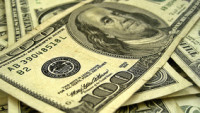 CAD
CAD
Canadian retail sales data should be in focus for loonie traders today. Markets are expecting a solid expansion in consumer activity, with headline sales likely to rise by 0.7% MoM in April. While this would more than offset a first set of print seen for March, we would still caution that this is hardly a ringing endorsement of consumer resilience in Canada. Granted, a reading that meets expectations would point to positive growth at the start of Q2. But it would also suggest that the per capita recession that has been underway in Canada for some time now will continue to drag on inflation, and that underlying economic momentum remains soft. As such, while markets may be inclined to take USDCAD lower on a positive headline reading today, the backdrop for the loonie remains negative, with the data continuing to suggest the BoC should be cutting rates again next month.
USD
The three European central bank decisions yesterday covered the entire spectrum of viable monetary decisions in this current climate. The Swiss National Bank cut rates for a second time in a decision, which in our view, was driven by their desire to weaken the currency and protect their export-oriented manufacturing industry. The Bank of England kept its powder dry, offering little additional guidance from its May decision, although there was a broad array of opinions amongst the Monetary Policy Committee over the timing of their first cut. Both Dhingra and Ramsdale voted to cut once again, while we suspect Mann and Green were amongst the group that decided to hold in a more hawkish manner, noting the need for further disinflation to ensure there was no residual persistence. The core of the committee largely looked through the recent overshoot in the inflation data, however, confirming our view that the Bank is on track to cut in August. Nowhere was it more visible that a central bank was looking through the recent data than in Norway, however, where policymakers decided to hold in the most hawkish manner possible. In its latest projections, the Norges Bank revised up its expectations for the policy rate and inflation, even as most price metrics had already undershot its previous forecasts. While we have reason to believe that the Norges Bank’s projections should be viewed as a signalling tool as opposed to an accurate forecasting exercise, the decision confirms our view that the Norges Bank is likely to be one of the handful of G10 central banks that lags the Fed in its easing cycle.
The decisions played out largely as expected in FX markets. The Norwegian krone notched incremental gains against the dollar, with more substantial ground made against the euro on the hawkish hold. Meanwhile, the pound sank against both the dollar and the euro as markets moderately dragged forward their easing expectations, while the Swiss franc sat firmly at the bottom of the daily rankings, to the delight of Swiss policymakers. The effects of yesterday’s decision are having a lingering effect, with the franc lower, pound flat, and krone slightly higher this morning, although it must be said that ranges are extremely tight across G10 markets. That might change later this morning, however, as flash PMIs are released out of Europe. Specific focus will be paid to the eurozone recovery and how firms report wage pressures, in terms of both input and output costs. With the euro already trading at a political discount, a downturn in leading growth or inflation indicators could make the bad situation turn worse. The UK edition will also be in scope, especially as the Bank staff have some confidence that the stickiness in wage pressures is transitory; any indication to the opposite could see sterling retrace some of yesterday’s BoE-induced decline.
While G10 FX showed some life yesterday, the excitement remained in EM markets. Having opened close to a percent stronger, the Brazilian real spent most of yesterday’s session retracing. While the move was in line with yields, it was notably that President Lula signalled his disappointment in the central bank’s decision. Although no secret, it once again highlights the risk to investors moving forward, which we suspect will cap participation in BRL longs. Moreover, the South African rand swung around in a 1.3% range, with investors still weighing a break of the 18.00 handle this morning. While the Mexican peso, which was the previously beloved EM currency, bucked the broader EM trend and notched gains as President-elect Sheinbaum announced fairly investor friendly members in her cabinet. The big news, however, came in China, where the onshore yuan hit a fresh seven-month high after the PBoC raised its daily fixing once again. Weakness in the yuan has continued this morning, dampening overall sentiment in EM currencies as a result.
EUR
As we had warned in recent days, short EURCHF positions as a European political risk hedge were beginning to look unattractive given entry levels and the risk that the SNB would cut rates. With the latter ultimately transpiring yesterday, and EURCHF rallying 0.4% as a result, it’s unsurprising that EURUSD bore the brunt as investors rotated into hedging the political risk outright. Whether or not that continues today will depend on Eurozone PMI data. While leading growth indicators such as new order books and employment decisions will be of focus, so too will be the overall French report given recent political events. While we doubt the PMIs capture the effects of the upcoming snap election, any signs that the political uncertainty is undermining the eurozone growth recovery, however small, will provide only another excuse for markets to dump the single currency. Given these risks, we suspect there remains further discount to be priced into EURUSD from here.
GBP
Despite holding rates yesterday, in a decision widely expected by markets, the BoE still managed to deliver something of a surprise. This came in the policy statement and accompanying minutes, both of which tilted dovish. While we had expected a runback of April’s messaging, an outcome that would have delivered a strong hint that an August rate cut was on the table, the MPC went one step further. Specifically, they indicated a willingness to look through the recent inflation stickiness seen in the wage and CPI data, removing from the equation the most significant factor that argues against cutting rates. Indeed, given a note in the minutes that the core of the committee now saw this latest decision as “finely balanced”, even having seen multiple data overshoots across most key indicators since the May meeting, we now think there is a very high bar to not cut rates in August. Markets seemingly agree too, pricing a two-in-three chance that the BoE cuts rates next time around. All told, this dovishness weighed on sterling yesterday, with the pound sliding 0.5% against the dollar and 0.1% against the euro. Short term risks are likely skewed towards further sterling downside too, particularly if the MPC doubles down on their dovish messaging following the end of the purdah period. Even so, we are still inclined to see the economic backdrop as constructive for the pound over the medium term, with economic growth set to offer sterling some notable upside support. This point was emphasised by May’s retail sales report, which posted a 2.9% rebound in May, way above expectations for 1.8% expansion and more than reversing a shockingly bad set of April prints. With this in hand, we suspect a robust GDP reading is in store for Q2. We think the UK economy likely expanded by more than 1.0% in the first half of the year, a view that should garner further support if the June PMI report published at 09:30 BST lands on expectations to indicate continued growth momentum.












